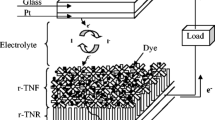Abstract
The low spectrum utilization and the recombination of photo-generated electrons are the main challenges for improving the performance of dye sensitized solar cells(DSSCs). In this article, a three-dimensional flower-like rutile titanium dioxide(TDF-TiO2) was successfully synthesized via a simple sol-thermal process. X-Ray diffraction patterns(XRD) and scan electron microscopy(SEM) images exhibit that the TDF-TiO2 are the rutile TiO2 microsphere composed of lots of regular cuboid nanorods. Applying this TDF-TiO2 as light scattering layer on the photoanode of DSSCs, the devices present an excellent photovoltage performance, yielding a power conversion efficiency(PCE) of 7.69%, which can be mainly attributed to the enhanced light utilization and the reduced recombination of pho-to-generated electrons upon a combined analysis of electrochemical impedance spectroscopy(EIS), open-circuit vol-tage decay(OCVD), and intensity-modulated photocurrent spectroscopy and intensity-modulated photovoltage spec-troscopy(IMPS/IMVS), etc. As a conclusion, TDF-TiO2 is a potential material as light scattering layer and optical transition medium to improve the performance of DSSCs, and this work further demonstrated that regulating the morphology and particle size of TiO2 is an efficient approach for enhancing the performance of DSSCs by optimizing the utilization of light and the transporting behaviors of photo-generated electrons.
Similar content being viewed by others
References
Subramaniam M. R., Kumaresan D., Chem. Phys. Chem., 2015, 16(12), 2543
Liu G., Yang H. G., Pan J., Yang Y. Q., Lu G. Q., Cheng H., Chem. Rev., 2014, 114(19), 9559
Wooh S., Yoon H., Jung J., Lee Y., Koh J., Lee B., Kang Y., Char K., Adv. Mater., 2013, 25(22), 3111
Li K., Xu J., Shi W., Wang Y., Peng T., J. Mater. Chem. A, 2014, 2(6), 1886
Wang B., Wan J., Liu Q., Zhang J., Wang H., RSC Adv., 2015, 5(101), 82968
Park K., Dhayal M., Electrochemi. Commun., 2014; 49, 47
Wang G., Zhu X., Yu J., J. Power Sources, 2015; 278, 344
Qadir M. B., Sun K. C., Sahito I. A., Arbab A. A., Choi B. J., Yi S. C., Jeong S. H., Sol. Energy Mater. Sol. Cells, 2015; 140, 141
Yan K., Qiu Y., Chen W., Zhang M., Yang S., Energy Environ. Sci., 2011, 4(6), 2168
Wen Q., Dong L., Sun X., Zhuang J., Chem. Res. Chinese Universi-ties, 2016, 32(3), 437
Wang W., Zhang H., Wang R., Feng M., Chen Y., Nanoscale, 2014, 6(4), 2390
Guo K., Li M., Fang X., Liu X., Zhu Y., Hu Z., Zhao X., J. Mater. Chem. A, 2013, 1(24), 7229
Sang L., Zhao Y., Burda C., Chem. Rev., 2014, 114(19), 9283
Sigmund W., Bak T., Alim M. A., Idris M., Ionescu M., Prince K., Sahdan M. Z., Sopian K., Teridie M., Sigmund W., Chem. Soc. Rev., 2015, 44(23), 8424
Fu Y., Peng M., Lv Z., Cai X., Hou S., Wu H., Yu X., Kafafy H., Zou D., Nano Energy, 2013, 2(4), 537
Wooh S., Kim T., Song D., Lee Y., Lee T., Bergmann V. W., Weber S., Bisquert J., Kang Y., Char K., ACS Appl. Mater. Interfaces, 2015, 7(46), 25741
Chen B., Sha J., Li W., Liu E., Shi C., He C., Li J., Zhao N., ACS Appl. Mater. Interfaces, 2016, 8(4), 2495
Yao N., Huang J., Fu K., Deng X., Ding M., Xu X., RSC Adv., 2016, 6(21), 17546
Wang X., Jiang Y., Zhu H., Zhang J., Chem. Res. Chinese Universi-ties, 2011, 27(3), 486
Wu W., Xu Y., Rao H., Su C., Kuang D., J Phys. Chem. C, 2014, 118(30), 16426
Ghadirzadeh A., Passoni L., Grancini G., Terraneo G., Bassi A., Pe-trozza A., Fonzo F., ACS Appl. Mater. Interfaces, 2015, 7(14), 7451
Qu J., Li G. R., Gao X. P., Energy Environ. Sci., 2010, 3(12), 2003
Ong W. J., Tan L. L., Chai S. P., Yong S., Mohamed A. R., Nanoscale, 2014, 6(4), 1946
Sarkar D., Ghosh C. K., Chattopadhyay K. K., Cryst. Eng. Comm, 2012, 14(8), 2683
Yan J., Liu P., Ma C., Lin Z., Yang G., Nanoscale, 2016, 8(16), 8826
Ding Y., Mo L., Tao L., Ma Y., Hu L., Huang Y., Fang X., Yao J., Xi X., Dai S., J. Power Sources, 2014; 272, 1046
Peng H., Li X., Xu L., Wu P., Chin. Chem. Lett., 2014, 24(7), 559
Tauc J., Grigorovic R., Vancu A., Phys. Stat. Sol., 1966, 15(2), 627
Pan J. H., Wang X. Z., Huang Q., Shen C., Koh Z. Y., Wang Q., En-gel A., Bahnemann D. W., Adv. Funct. Mater., 2014, 24(1), 95
Gu J., Khan J., Chai Z., Yuan Y., Yu X., Liu P., Wu M., Ma W., J. Power Sources, 2016; 303, 57
Liu W., Liang Z., Kou D., Hu L., Dai S., Chem. J. Chinese Universi-ties, 2012, 33(12), 2697
Bisquert J., Fabregat-Santiago F., Mora-Seró I., Garcia-Belmonte G., Giménez S., J. Phys. Chem. C, 2009, 113(40), 17278
Wei L., Na Y., Yang Y., Fan R., Wang P., Li L., Phys. Chem. Chem. Phys., 2015, 17(2), 1273
Wang H., Bai Y., Wu Q., Zhou W., Zhang H., Li J., Guo L., Phys. Chem. Chem. Phys., 2011, 13(15), 7008
Zaban A., Greenshtein M., Bisquert J., Chem. Phys. Chem., 2003, 4(8), 859
Miao X., Pan K., Liao Y., Zhou W., Pan Q., Tian G., Wang G., J. Mater. Chem. A, 2013, 1(34), 98532
Author information
Authors and Affiliations
Corresponding authors
Additional information
Supported by the National Natural Science Foundation of China(Nos.21571042, 21371040) and the National Key Basic Research Program of China(No.2013CB632900).
Electronic Supplementary Material Supplementary material is available in the online version of this article at http://dx.doi.org/10.1007/s40242-017-6363-z.
Electronic supplementary material
40242_2017_6363_MOESM1_ESM.pdf
Three-dimensional flower-like rutile TiO2 composed of nanorods: a promising candidate as light scattering layer for DSSCs
Rights and permissions
About this article
Cite this article
Shi, Y., Yang, Y., Dong, G. et al. Three-dimensional flower-like rutile TiO2 microsphere composed of nanorods: a potential material as light scattering layer for DSSCs. Chem. Res. Chin. Univ. 33, 298–304 (2017). https://doi.org/10.1007/s40242-017-6363-z
Received:
Accepted:
Published:
Issue Date:
DOI: https://doi.org/10.1007/s40242-017-6363-z




